Design and Implementation of an ATM System using Object Modeling
VerifiedAdded on 2023/06/13
|12
|2266
|146
Project
AI Summary
This project focuses on designing an Automated Teller Machine (ATM) system using object modeling techniques. It includes a project overview, aims, and objectives, followed by a discussion of the ATM's functionalities. The project outlines both functional and non-functional requirements, presenting use case models illustrating interactions between the ATM and various actors such as operators, customers, and bank officers. A class diagram showcases the relationships between entities like Bank, Customer, Account, and Transactions. Furthermore, the project delves into the Software Development Life Cycle (SDLC) design activities, covering the environment, application components, user interfaces, database design, and software methods used. The analysis provides a comprehensive understanding of the ATM system's design and operation, concluding with references to relevant research papers.

Object Modeling
Paraphrase This Document
Need a fresh take? Get an instant paraphrase of this document with our AI Paraphraser
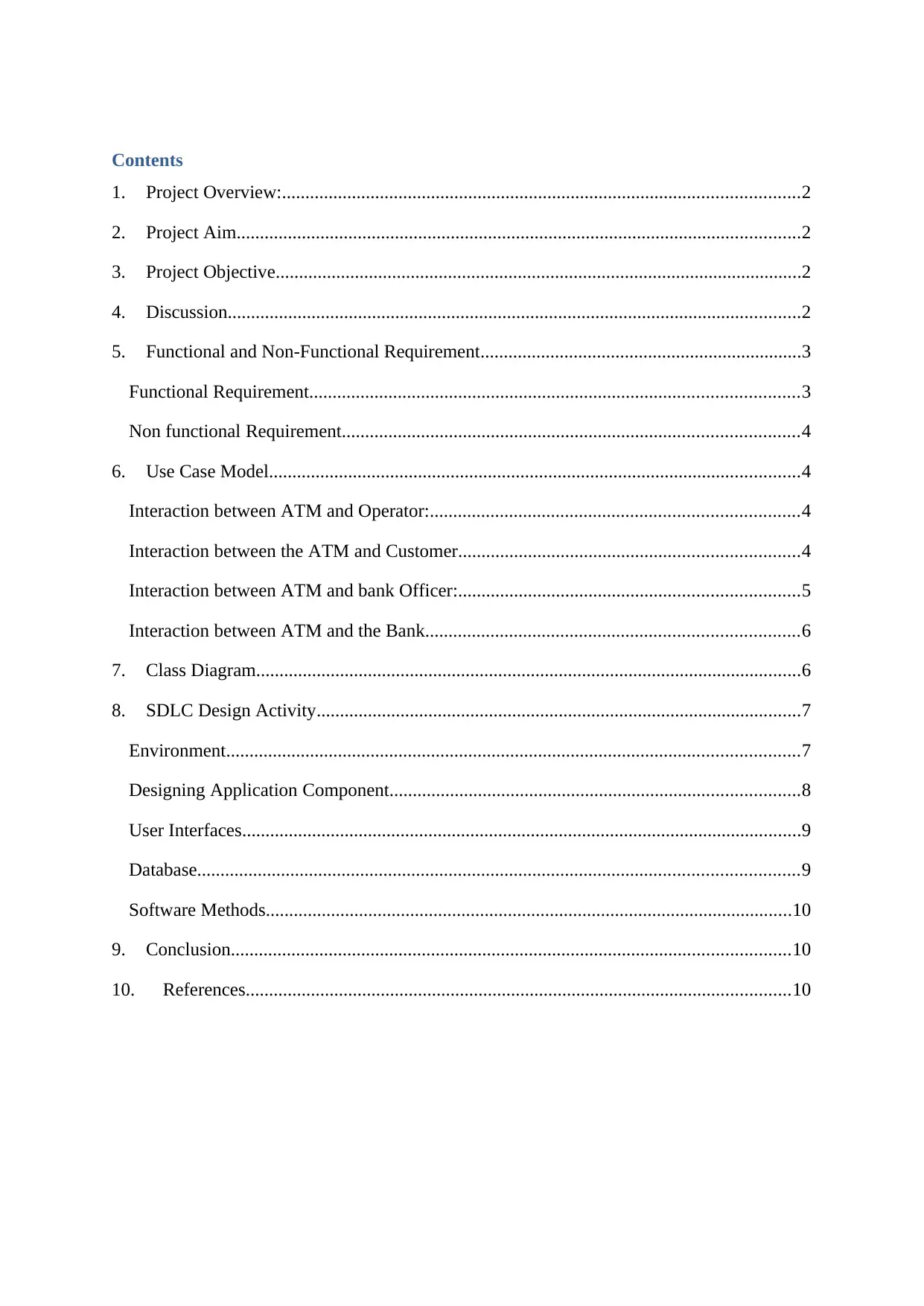
Contents
1. Project Overview:...............................................................................................................2
2. Project Aim.........................................................................................................................2
3. Project Objective.................................................................................................................2
4. Discussion...........................................................................................................................2
5. Functional and Non-Functional Requirement.....................................................................3
Functional Requirement.........................................................................................................3
Non functional Requirement..................................................................................................4
6. Use Case Model..................................................................................................................4
Interaction between ATM and Operator:...............................................................................4
Interaction between the ATM and Customer.........................................................................4
Interaction between ATM and bank Officer:.........................................................................5
Interaction between ATM and the Bank................................................................................6
7. Class Diagram.....................................................................................................................6
8. SDLC Design Activity........................................................................................................7
Environment...........................................................................................................................7
Designing Application Component........................................................................................8
User Interfaces........................................................................................................................9
Database.................................................................................................................................9
Software Methods.................................................................................................................10
9. Conclusion........................................................................................................................10
10. References.....................................................................................................................10
1. Project Overview:...............................................................................................................2
2. Project Aim.........................................................................................................................2
3. Project Objective.................................................................................................................2
4. Discussion...........................................................................................................................2
5. Functional and Non-Functional Requirement.....................................................................3
Functional Requirement.........................................................................................................3
Non functional Requirement..................................................................................................4
6. Use Case Model..................................................................................................................4
Interaction between ATM and Operator:...............................................................................4
Interaction between the ATM and Customer.........................................................................4
Interaction between ATM and bank Officer:.........................................................................5
Interaction between ATM and the Bank................................................................................6
7. Class Diagram.....................................................................................................................6
8. SDLC Design Activity........................................................................................................7
Environment...........................................................................................................................7
Designing Application Component........................................................................................8
User Interfaces........................................................................................................................9
Database.................................................................................................................................9
Software Methods.................................................................................................................10
9. Conclusion........................................................................................................................10
10. References.....................................................................................................................10
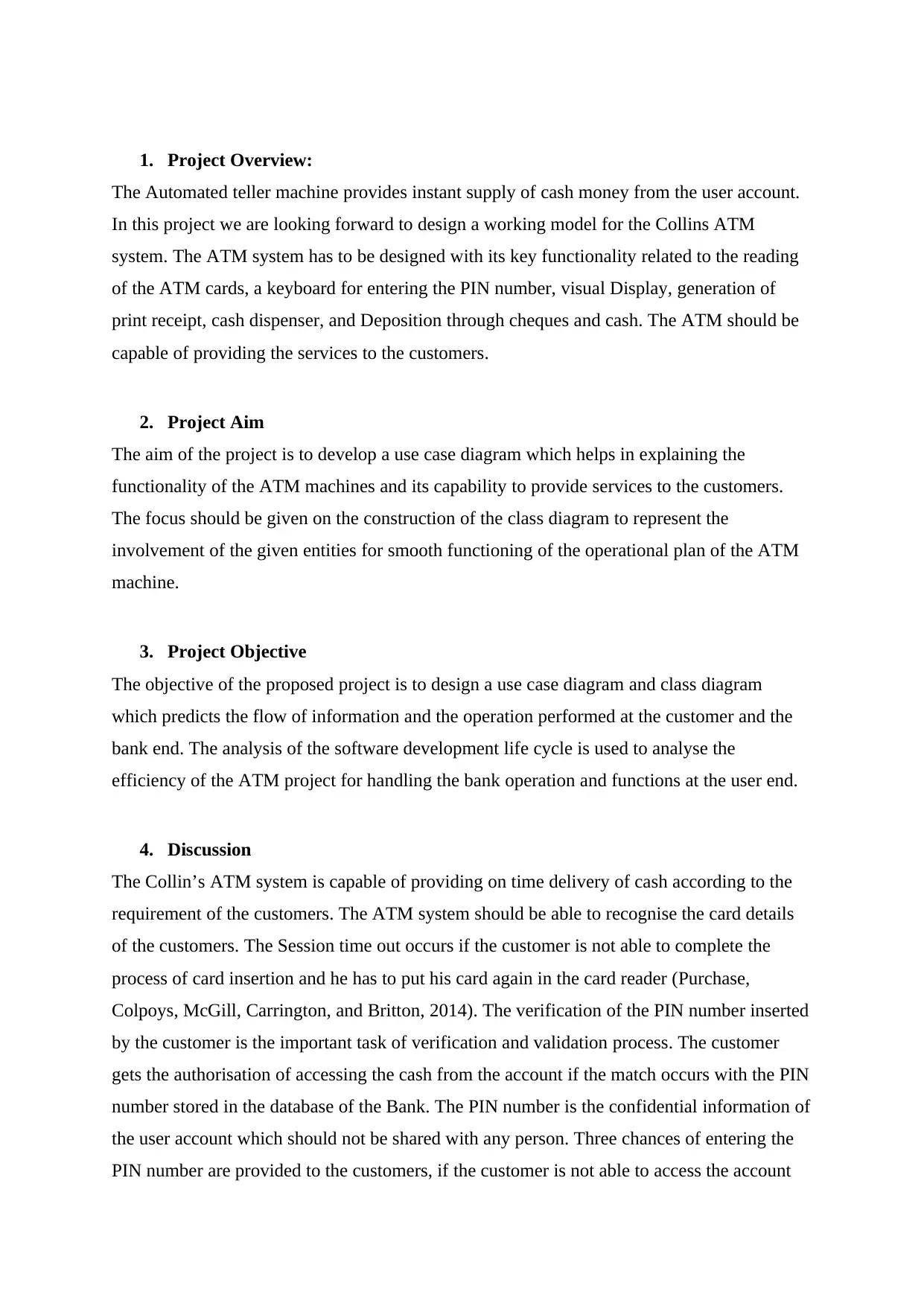
1. Project Overview:
The Automated teller machine provides instant supply of cash money from the user account.
In this project we are looking forward to design a working model for the Collins ATM
system. The ATM system has to be designed with its key functionality related to the reading
of the ATM cards, a keyboard for entering the PIN number, visual Display, generation of
print receipt, cash dispenser, and Deposition through cheques and cash. The ATM should be
capable of providing the services to the customers.
2. Project Aim
The aim of the project is to develop a use case diagram which helps in explaining the
functionality of the ATM machines and its capability to provide services to the customers.
The focus should be given on the construction of the class diagram to represent the
involvement of the given entities for smooth functioning of the operational plan of the ATM
machine.
3. Project Objective
The objective of the proposed project is to design a use case diagram and class diagram
which predicts the flow of information and the operation performed at the customer and the
bank end. The analysis of the software development life cycle is used to analyse the
efficiency of the ATM project for handling the bank operation and functions at the user end.
4. Discussion
The Collin’s ATM system is capable of providing on time delivery of cash according to the
requirement of the customers. The ATM system should be able to recognise the card details
of the customers. The Session time out occurs if the customer is not able to complete the
process of card insertion and he has to put his card again in the card reader (Purchase,
Colpoys, McGill, Carrington, and Britton, 2014). The verification of the PIN number inserted
by the customer is the important task of verification and validation process. The customer
gets the authorisation of accessing the cash from the account if the match occurs with the PIN
number stored in the database of the Bank. The PIN number is the confidential information of
the user account which should not be shared with any person. Three chances of entering the
PIN number are provided to the customers, if the customer is not able to access the account
The Automated teller machine provides instant supply of cash money from the user account.
In this project we are looking forward to design a working model for the Collins ATM
system. The ATM system has to be designed with its key functionality related to the reading
of the ATM cards, a keyboard for entering the PIN number, visual Display, generation of
print receipt, cash dispenser, and Deposition through cheques and cash. The ATM should be
capable of providing the services to the customers.
2. Project Aim
The aim of the project is to develop a use case diagram which helps in explaining the
functionality of the ATM machines and its capability to provide services to the customers.
The focus should be given on the construction of the class diagram to represent the
involvement of the given entities for smooth functioning of the operational plan of the ATM
machine.
3. Project Objective
The objective of the proposed project is to design a use case diagram and class diagram
which predicts the flow of information and the operation performed at the customer and the
bank end. The analysis of the software development life cycle is used to analyse the
efficiency of the ATM project for handling the bank operation and functions at the user end.
4. Discussion
The Collin’s ATM system is capable of providing on time delivery of cash according to the
requirement of the customers. The ATM system should be able to recognise the card details
of the customers. The Session time out occurs if the customer is not able to complete the
process of card insertion and he has to put his card again in the card reader (Purchase,
Colpoys, McGill, Carrington, and Britton, 2014). The verification of the PIN number inserted
by the customer is the important task of verification and validation process. The customer
gets the authorisation of accessing the cash from the account if the match occurs with the PIN
number stored in the database of the Bank. The PIN number is the confidential information of
the user account which should not be shared with any person. Three chances of entering the
PIN number are provided to the customers, if the customer is not able to access the account
You're viewing a preview
Unlock full access by subscribing today!
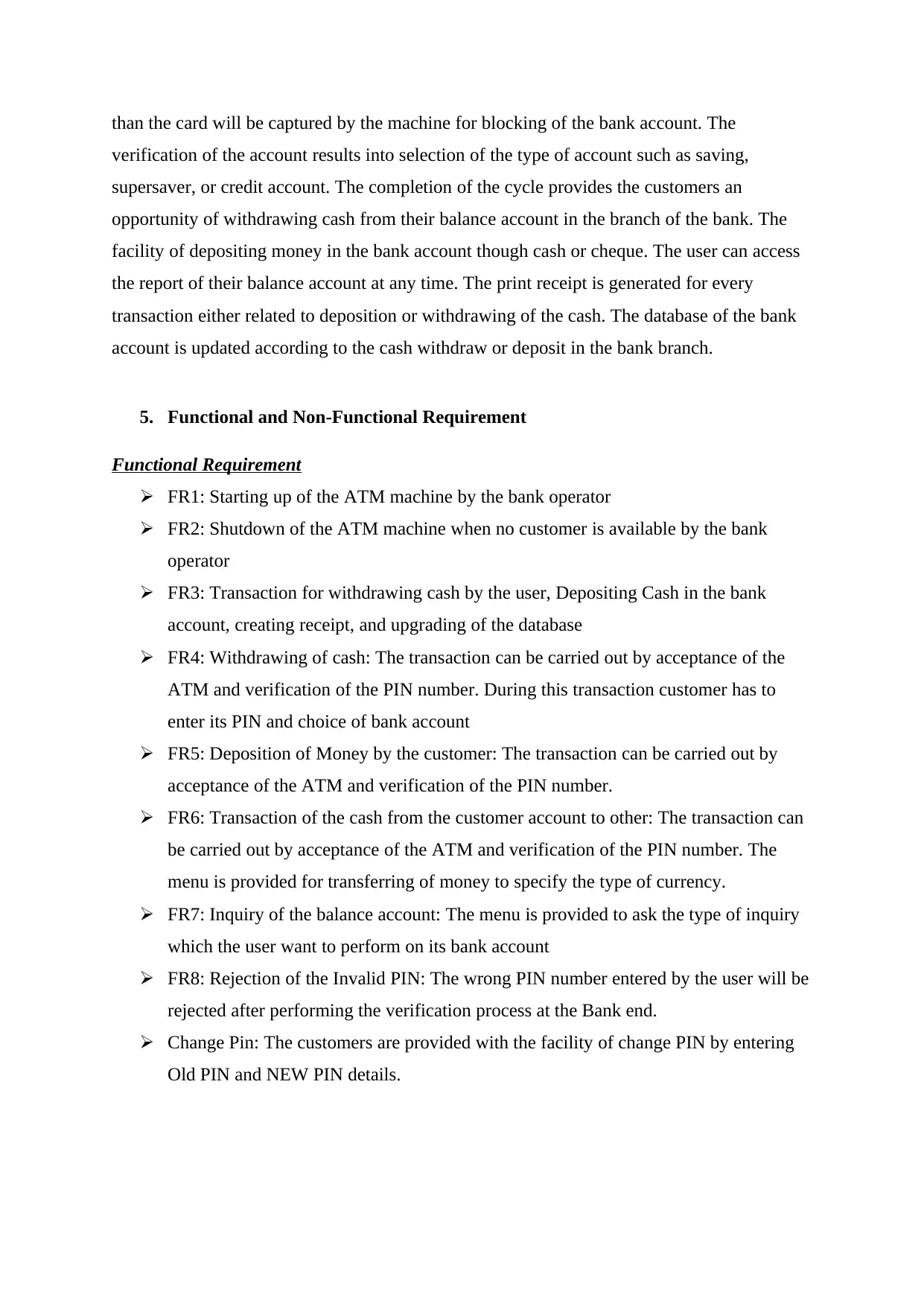
than the card will be captured by the machine for blocking of the bank account. The
verification of the account results into selection of the type of account such as saving,
supersaver, or credit account. The completion of the cycle provides the customers an
opportunity of withdrawing cash from their balance account in the branch of the bank. The
facility of depositing money in the bank account though cash or cheque. The user can access
the report of their balance account at any time. The print receipt is generated for every
transaction either related to deposition or withdrawing of the cash. The database of the bank
account is updated according to the cash withdraw or deposit in the bank branch.
5. Functional and Non-Functional Requirement
Functional Requirement
FR1: Starting up of the ATM machine by the bank operator
FR2: Shutdown of the ATM machine when no customer is available by the bank
operator
FR3: Transaction for withdrawing cash by the user, Depositing Cash in the bank
account, creating receipt, and upgrading of the database
FR4: Withdrawing of cash: The transaction can be carried out by acceptance of the
ATM and verification of the PIN number. During this transaction customer has to
enter its PIN and choice of bank account
FR5: Deposition of Money by the customer: The transaction can be carried out by
acceptance of the ATM and verification of the PIN number.
FR6: Transaction of the cash from the customer account to other: The transaction can
be carried out by acceptance of the ATM and verification of the PIN number. The
menu is provided for transferring of money to specify the type of currency.
FR7: Inquiry of the balance account: The menu is provided to ask the type of inquiry
which the user want to perform on its bank account
FR8: Rejection of the Invalid PIN: The wrong PIN number entered by the user will be
rejected after performing the verification process at the Bank end.
Change Pin: The customers are provided with the facility of change PIN by entering
Old PIN and NEW PIN details.
verification of the account results into selection of the type of account such as saving,
supersaver, or credit account. The completion of the cycle provides the customers an
opportunity of withdrawing cash from their balance account in the branch of the bank. The
facility of depositing money in the bank account though cash or cheque. The user can access
the report of their balance account at any time. The print receipt is generated for every
transaction either related to deposition or withdrawing of the cash. The database of the bank
account is updated according to the cash withdraw or deposit in the bank branch.
5. Functional and Non-Functional Requirement
Functional Requirement
FR1: Starting up of the ATM machine by the bank operator
FR2: Shutdown of the ATM machine when no customer is available by the bank
operator
FR3: Transaction for withdrawing cash by the user, Depositing Cash in the bank
account, creating receipt, and upgrading of the database
FR4: Withdrawing of cash: The transaction can be carried out by acceptance of the
ATM and verification of the PIN number. During this transaction customer has to
enter its PIN and choice of bank account
FR5: Deposition of Money by the customer: The transaction can be carried out by
acceptance of the ATM and verification of the PIN number.
FR6: Transaction of the cash from the customer account to other: The transaction can
be carried out by acceptance of the ATM and verification of the PIN number. The
menu is provided for transferring of money to specify the type of currency.
FR7: Inquiry of the balance account: The menu is provided to ask the type of inquiry
which the user want to perform on its bank account
FR8: Rejection of the Invalid PIN: The wrong PIN number entered by the user will be
rejected after performing the verification process at the Bank end.
Change Pin: The customers are provided with the facility of change PIN by entering
Old PIN and NEW PIN details.
Paraphrase This Document
Need a fresh take? Get an instant paraphrase of this document with our AI Paraphraser
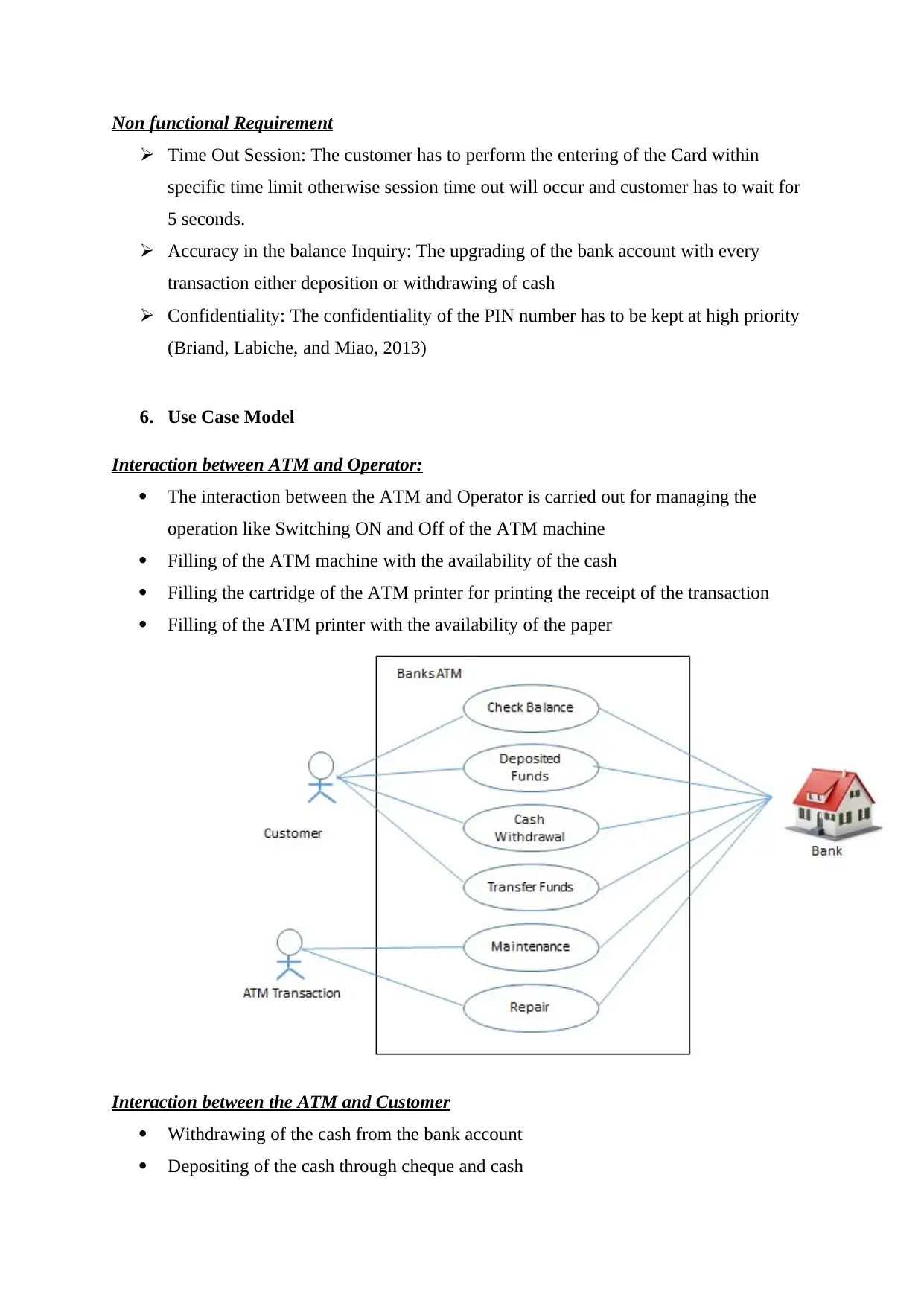
Non functional Requirement
Time Out Session: The customer has to perform the entering of the Card within
specific time limit otherwise session time out will occur and customer has to wait for
5 seconds.
Accuracy in the balance Inquiry: The upgrading of the bank account with every
transaction either deposition or withdrawing of cash
Confidentiality: The confidentiality of the PIN number has to be kept at high priority
(Briand, Labiche, and Miao, 2013)
6. Use Case Model
Interaction between ATM and Operator:
The interaction between the ATM and Operator is carried out for managing the
operation like Switching ON and Off of the ATM machine
Filling of the ATM machine with the availability of the cash
Filling the cartridge of the ATM printer for printing the receipt of the transaction
Filling of the ATM printer with the availability of the paper
Interaction between the ATM and Customer
Withdrawing of the cash from the bank account
Depositing of the cash through cheque and cash
Time Out Session: The customer has to perform the entering of the Card within
specific time limit otherwise session time out will occur and customer has to wait for
5 seconds.
Accuracy in the balance Inquiry: The upgrading of the bank account with every
transaction either deposition or withdrawing of cash
Confidentiality: The confidentiality of the PIN number has to be kept at high priority
(Briand, Labiche, and Miao, 2013)
6. Use Case Model
Interaction between ATM and Operator:
The interaction between the ATM and Operator is carried out for managing the
operation like Switching ON and Off of the ATM machine
Filling of the ATM machine with the availability of the cash
Filling the cartridge of the ATM printer for printing the receipt of the transaction
Filling of the ATM printer with the availability of the paper
Interaction between the ATM and Customer
Withdrawing of the cash from the bank account
Depositing of the cash through cheque and cash
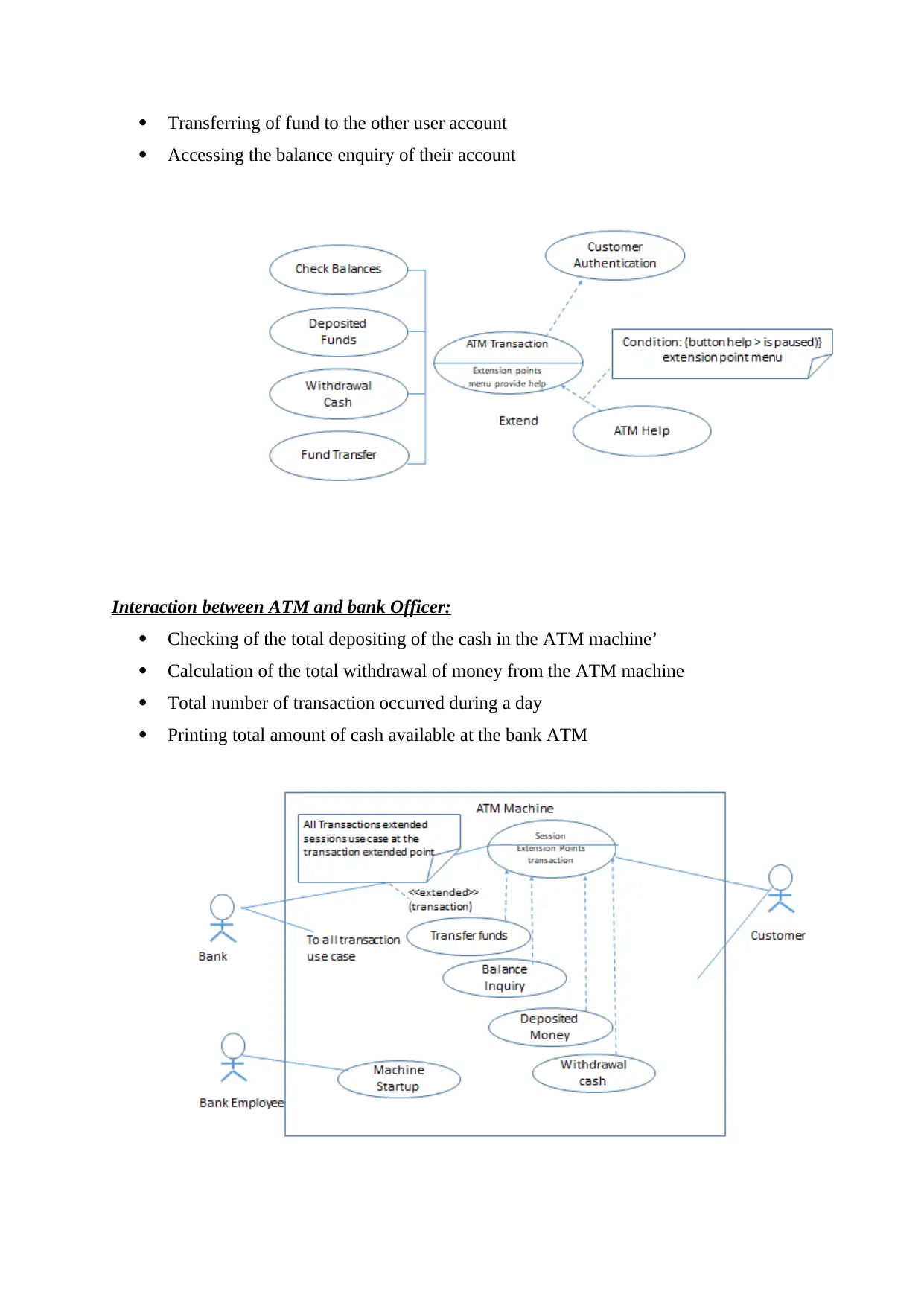
Transferring of fund to the other user account
Accessing the balance enquiry of their account
Interaction between ATM and bank Officer:
Checking of the total depositing of the cash in the ATM machine’
Calculation of the total withdrawal of money from the ATM machine
Total number of transaction occurred during a day
Printing total amount of cash available at the bank ATM
Accessing the balance enquiry of their account
Interaction between ATM and bank Officer:
Checking of the total depositing of the cash in the ATM machine’
Calculation of the total withdrawal of money from the ATM machine
Total number of transaction occurred during a day
Printing total amount of cash available at the bank ATM
You're viewing a preview
Unlock full access by subscribing today!
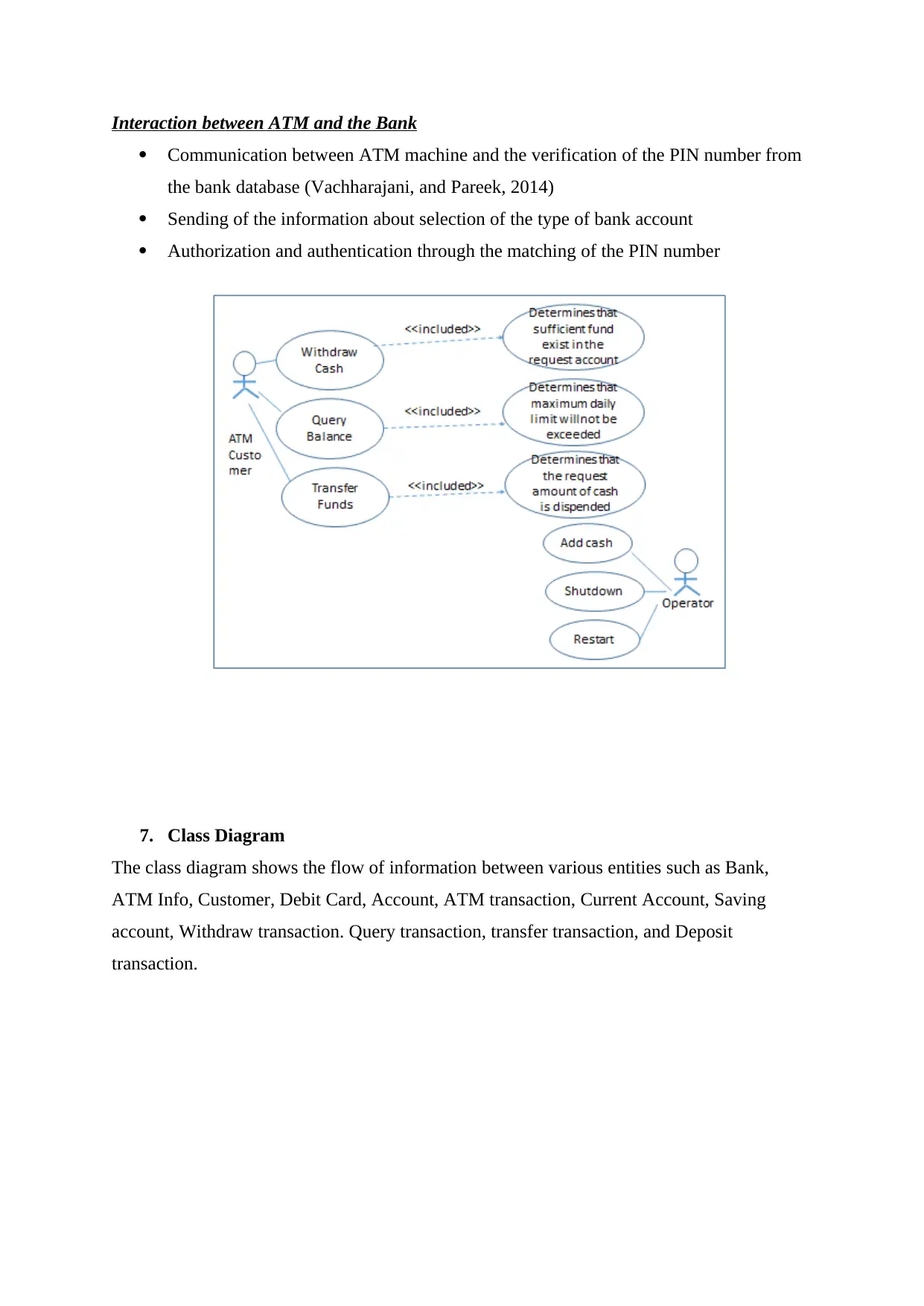
Interaction between ATM and the Bank
Communication between ATM machine and the verification of the PIN number from
the bank database (Vachharajani, and Pareek, 2014)
Sending of the information about selection of the type of bank account
Authorization and authentication through the matching of the PIN number
7. Class Diagram
The class diagram shows the flow of information between various entities such as Bank,
ATM Info, Customer, Debit Card, Account, ATM transaction, Current Account, Saving
account, Withdraw transaction. Query transaction, transfer transaction, and Deposit
transaction.
Communication between ATM machine and the verification of the PIN number from
the bank database (Vachharajani, and Pareek, 2014)
Sending of the information about selection of the type of bank account
Authorization and authentication through the matching of the PIN number
7. Class Diagram
The class diagram shows the flow of information between various entities such as Bank,
ATM Info, Customer, Debit Card, Account, ATM transaction, Current Account, Saving
account, Withdraw transaction. Query transaction, transfer transaction, and Deposit
transaction.
Paraphrase This Document
Need a fresh take? Get an instant paraphrase of this document with our AI Paraphraser
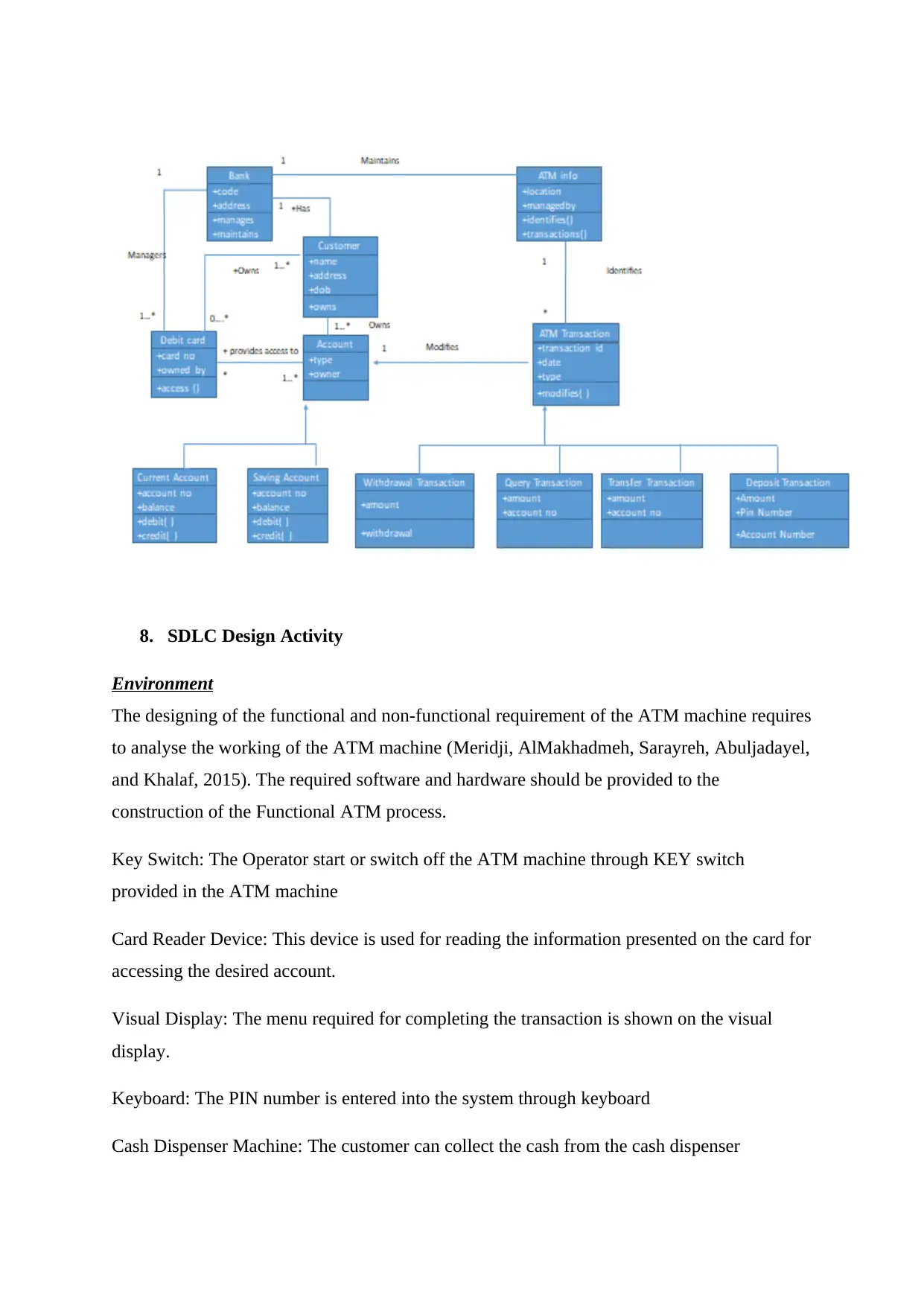
8. SDLC Design Activity
Environment
The designing of the functional and non-functional requirement of the ATM machine requires
to analyse the working of the ATM machine (Meridji, AlMakhadmeh, Sarayreh, Abuljadayel,
and Khalaf, 2015). The required software and hardware should be provided to the
construction of the Functional ATM process.
Key Switch: The Operator start or switch off the ATM machine through KEY switch
provided in the ATM machine
Card Reader Device: This device is used for reading the information presented on the card for
accessing the desired account.
Visual Display: The menu required for completing the transaction is shown on the visual
display.
Keyboard: The PIN number is entered into the system through keyboard
Cash Dispenser Machine: The customer can collect the cash from the cash dispenser
Environment
The designing of the functional and non-functional requirement of the ATM machine requires
to analyse the working of the ATM machine (Meridji, AlMakhadmeh, Sarayreh, Abuljadayel,
and Khalaf, 2015). The required software and hardware should be provided to the
construction of the Functional ATM process.
Key Switch: The Operator start or switch off the ATM machine through KEY switch
provided in the ATM machine
Card Reader Device: This device is used for reading the information presented on the card for
accessing the desired account.
Visual Display: The menu required for completing the transaction is shown on the visual
display.
Keyboard: The PIN number is entered into the system through keyboard
Cash Dispenser Machine: The customer can collect the cash from the cash dispenser
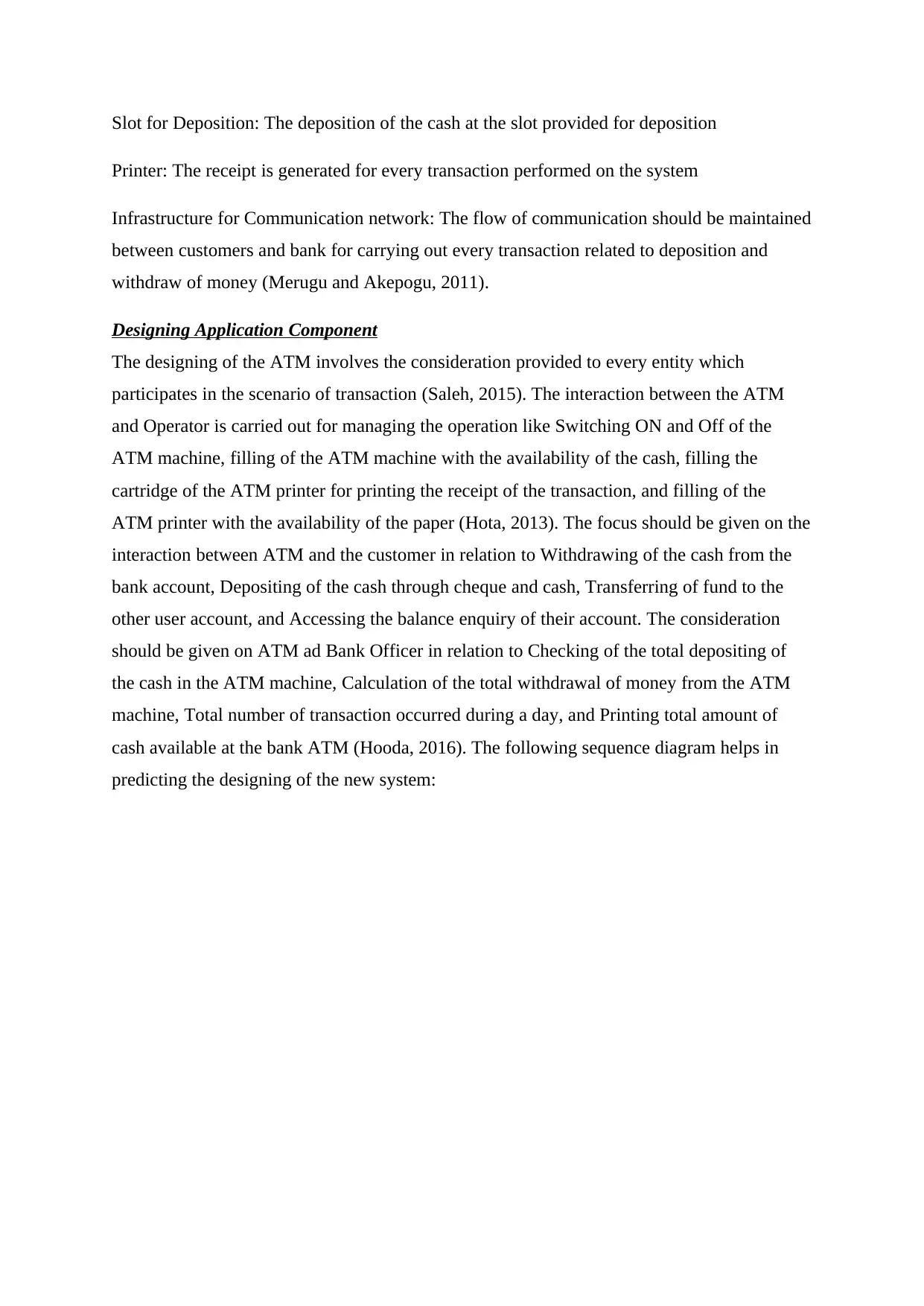
Slot for Deposition: The deposition of the cash at the slot provided for deposition
Printer: The receipt is generated for every transaction performed on the system
Infrastructure for Communication network: The flow of communication should be maintained
between customers and bank for carrying out every transaction related to deposition and
withdraw of money (Merugu and Akepogu, 2011).
Designing Application Component
The designing of the ATM involves the consideration provided to every entity which
participates in the scenario of transaction (Saleh, 2015). The interaction between the ATM
and Operator is carried out for managing the operation like Switching ON and Off of the
ATM machine, filling of the ATM machine with the availability of the cash, filling the
cartridge of the ATM printer for printing the receipt of the transaction, and filling of the
ATM printer with the availability of the paper (Hota, 2013). The focus should be given on the
interaction between ATM and the customer in relation to Withdrawing of the cash from the
bank account, Depositing of the cash through cheque and cash, Transferring of fund to the
other user account, and Accessing the balance enquiry of their account. The consideration
should be given on ATM ad Bank Officer in relation to Checking of the total depositing of
the cash in the ATM machine, Calculation of the total withdrawal of money from the ATM
machine, Total number of transaction occurred during a day, and Printing total amount of
cash available at the bank ATM (Hooda, 2016). The following sequence diagram helps in
predicting the designing of the new system:
Printer: The receipt is generated for every transaction performed on the system
Infrastructure for Communication network: The flow of communication should be maintained
between customers and bank for carrying out every transaction related to deposition and
withdraw of money (Merugu and Akepogu, 2011).
Designing Application Component
The designing of the ATM involves the consideration provided to every entity which
participates in the scenario of transaction (Saleh, 2015). The interaction between the ATM
and Operator is carried out for managing the operation like Switching ON and Off of the
ATM machine, filling of the ATM machine with the availability of the cash, filling the
cartridge of the ATM printer for printing the receipt of the transaction, and filling of the
ATM printer with the availability of the paper (Hota, 2013). The focus should be given on the
interaction between ATM and the customer in relation to Withdrawing of the cash from the
bank account, Depositing of the cash through cheque and cash, Transferring of fund to the
other user account, and Accessing the balance enquiry of their account. The consideration
should be given on ATM ad Bank Officer in relation to Checking of the total depositing of
the cash in the ATM machine, Calculation of the total withdrawal of money from the ATM
machine, Total number of transaction occurred during a day, and Printing total amount of
cash available at the bank ATM (Hooda, 2016). The following sequence diagram helps in
predicting the designing of the new system:
You're viewing a preview
Unlock full access by subscribing today!
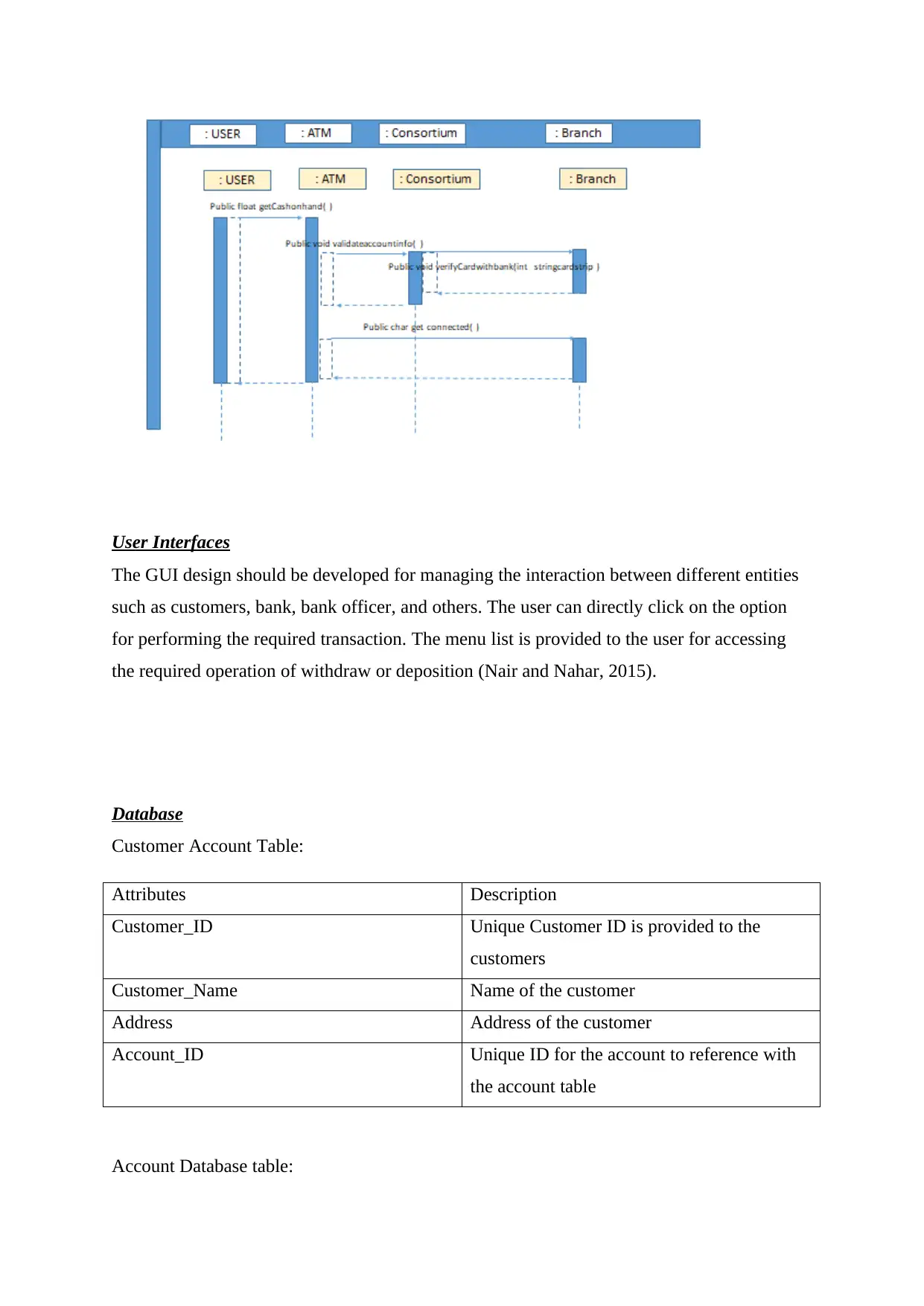
User Interfaces
The GUI design should be developed for managing the interaction between different entities
such as customers, bank, bank officer, and others. The user can directly click on the option
for performing the required transaction. The menu list is provided to the user for accessing
the required operation of withdraw or deposition (Nair and Nahar, 2015).
Database
Customer Account Table:
Attributes Description
Customer_ID Unique Customer ID is provided to the
customers
Customer_Name Name of the customer
Address Address of the customer
Account_ID Unique ID for the account to reference with
the account table
Account Database table:
The GUI design should be developed for managing the interaction between different entities
such as customers, bank, bank officer, and others. The user can directly click on the option
for performing the required transaction. The menu list is provided to the user for accessing
the required operation of withdraw or deposition (Nair and Nahar, 2015).
Database
Customer Account Table:
Attributes Description
Customer_ID Unique Customer ID is provided to the
customers
Customer_Name Name of the customer
Address Address of the customer
Account_ID Unique ID for the account to reference with
the account table
Account Database table:
Paraphrase This Document
Need a fresh take? Get an instant paraphrase of this document with our AI Paraphraser
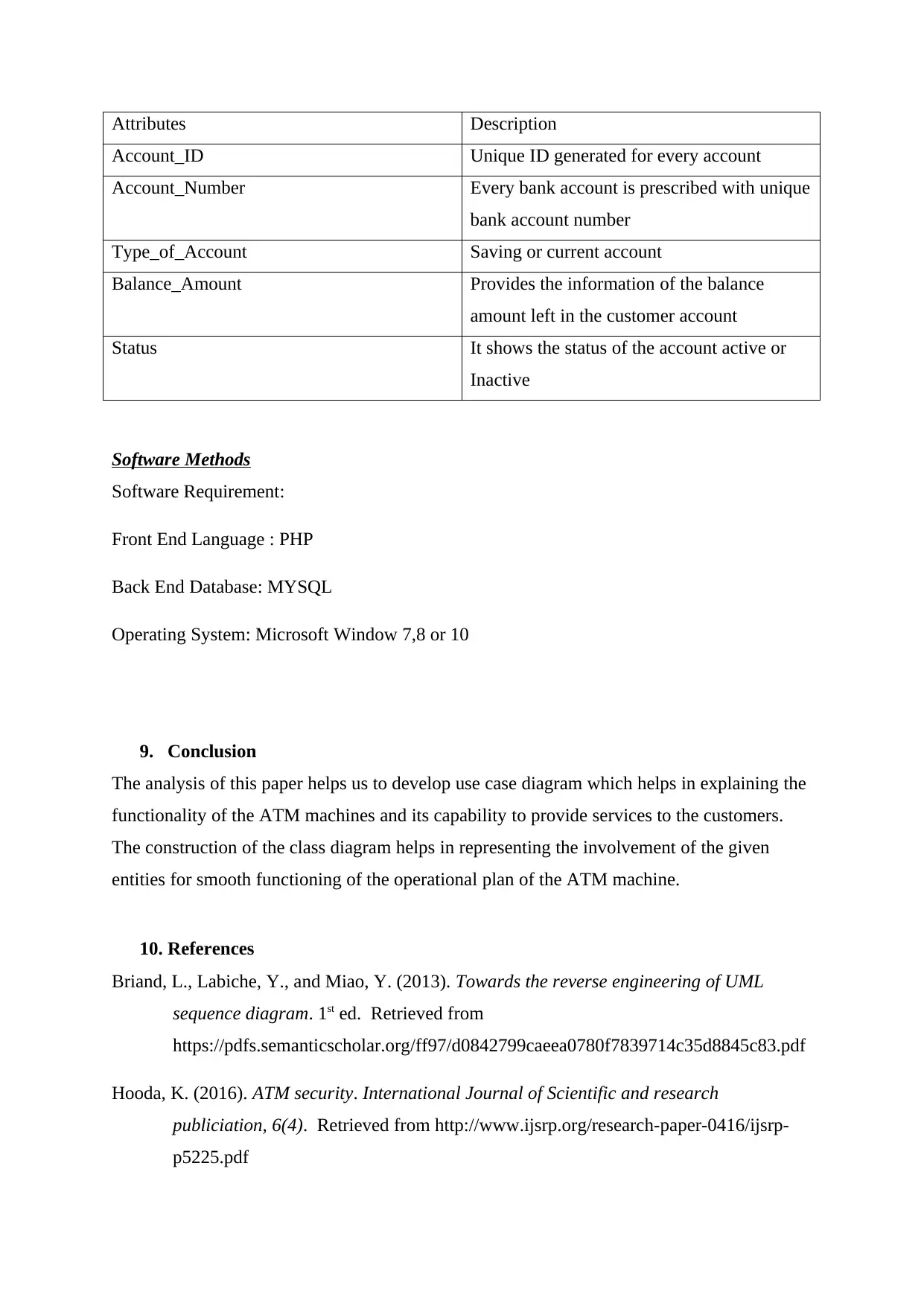
Attributes Description
Account_ID Unique ID generated for every account
Account_Number Every bank account is prescribed with unique
bank account number
Type_of_Account Saving or current account
Balance_Amount Provides the information of the balance
amount left in the customer account
Status It shows the status of the account active or
Inactive
Software Methods
Software Requirement:
Front End Language : PHP
Back End Database: MYSQL
Operating System: Microsoft Window 7,8 or 10
9. Conclusion
The analysis of this paper helps us to develop use case diagram which helps in explaining the
functionality of the ATM machines and its capability to provide services to the customers.
The construction of the class diagram helps in representing the involvement of the given
entities for smooth functioning of the operational plan of the ATM machine.
10. References
Briand, L., Labiche, Y., and Miao, Y. (2013). Towards the reverse engineering of UML
sequence diagram. 1st ed. Retrieved from
https://pdfs.semanticscholar.org/ff97/d0842799caeea0780f7839714c35d8845c83.pdf
Hooda, K. (2016). ATM security. International Journal of Scientific and research
publiciation, 6(4). Retrieved from http://www.ijsrp.org/research-paper-0416/ijsrp-
p5225.pdf
Account_ID Unique ID generated for every account
Account_Number Every bank account is prescribed with unique
bank account number
Type_of_Account Saving or current account
Balance_Amount Provides the information of the balance
amount left in the customer account
Status It shows the status of the account active or
Inactive
Software Methods
Software Requirement:
Front End Language : PHP
Back End Database: MYSQL
Operating System: Microsoft Window 7,8 or 10
9. Conclusion
The analysis of this paper helps us to develop use case diagram which helps in explaining the
functionality of the ATM machines and its capability to provide services to the customers.
The construction of the class diagram helps in representing the involvement of the given
entities for smooth functioning of the operational plan of the ATM machine.
10. References
Briand, L., Labiche, Y., and Miao, Y. (2013). Towards the reverse engineering of UML
sequence diagram. 1st ed. Retrieved from
https://pdfs.semanticscholar.org/ff97/d0842799caeea0780f7839714c35d8845c83.pdf
Hooda, K. (2016). ATM security. International Journal of Scientific and research
publiciation, 6(4). Retrieved from http://www.ijsrp.org/research-paper-0416/ijsrp-
p5225.pdf
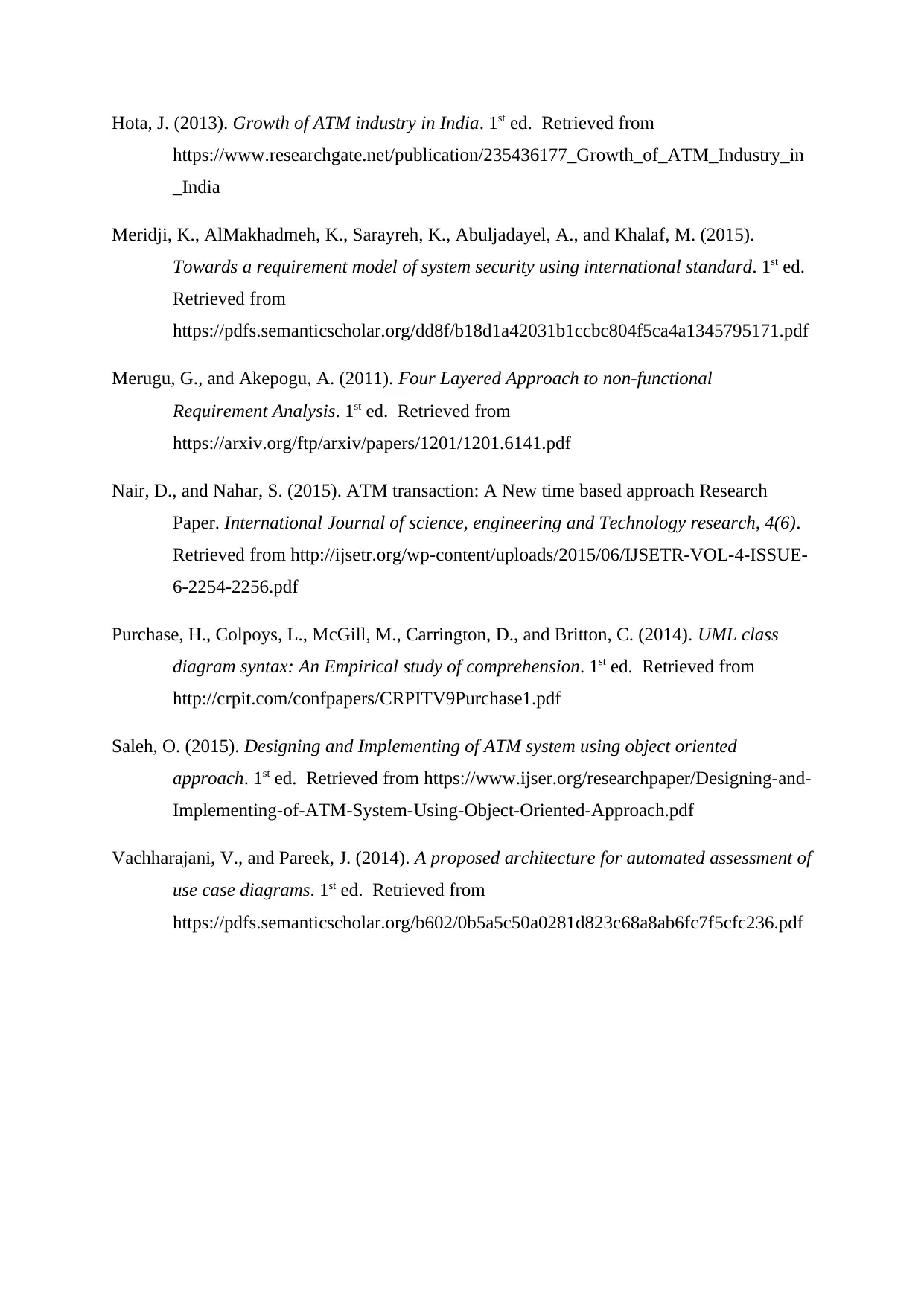
Hota, J. (2013). Growth of ATM industry in India. 1st ed. Retrieved from
https://www.researchgate.net/publication/235436177_Growth_of_ATM_Industry_in
_India
Meridji, K., AlMakhadmeh, K., Sarayreh, K., Abuljadayel, A., and Khalaf, M. (2015).
Towards a requirement model of system security using international standard. 1st ed.
Retrieved from
https://pdfs.semanticscholar.org/dd8f/b18d1a42031b1ccbc804f5ca4a1345795171.pdf
Merugu, G., and Akepogu, A. (2011). Four Layered Approach to non-functional
Requirement Analysis. 1st ed. Retrieved from
https://arxiv.org/ftp/arxiv/papers/1201/1201.6141.pdf
Nair, D., and Nahar, S. (2015). ATM transaction: A New time based approach Research
Paper. International Journal of science, engineering and Technology research, 4(6).
Retrieved from http://ijsetr.org/wp-content/uploads/2015/06/IJSETR-VOL-4-ISSUE-
6-2254-2256.pdf
Purchase, H., Colpoys, L., McGill, M., Carrington, D., and Britton, C. (2014). UML class
diagram syntax: An Empirical study of comprehension. 1st ed. Retrieved from
http://crpit.com/confpapers/CRPITV9Purchase1.pdf
Saleh, O. (2015). Designing and Implementing of ATM system using object oriented
approach. 1st ed. Retrieved from https://www.ijser.org/researchpaper/Designing-and-
Implementing-of-ATM-System-Using-Object-Oriented-Approach.pdf
Vachharajani, V., and Pareek, J. (2014). A proposed architecture for automated assessment of
use case diagrams. 1st ed. Retrieved from
https://pdfs.semanticscholar.org/b602/0b5a5c50a0281d823c68a8ab6fc7f5cfc236.pdf
https://www.researchgate.net/publication/235436177_Growth_of_ATM_Industry_in
_India
Meridji, K., AlMakhadmeh, K., Sarayreh, K., Abuljadayel, A., and Khalaf, M. (2015).
Towards a requirement model of system security using international standard. 1st ed.
Retrieved from
https://pdfs.semanticscholar.org/dd8f/b18d1a42031b1ccbc804f5ca4a1345795171.pdf
Merugu, G., and Akepogu, A. (2011). Four Layered Approach to non-functional
Requirement Analysis. 1st ed. Retrieved from
https://arxiv.org/ftp/arxiv/papers/1201/1201.6141.pdf
Nair, D., and Nahar, S. (2015). ATM transaction: A New time based approach Research
Paper. International Journal of science, engineering and Technology research, 4(6).
Retrieved from http://ijsetr.org/wp-content/uploads/2015/06/IJSETR-VOL-4-ISSUE-
6-2254-2256.pdf
Purchase, H., Colpoys, L., McGill, M., Carrington, D., and Britton, C. (2014). UML class
diagram syntax: An Empirical study of comprehension. 1st ed. Retrieved from
http://crpit.com/confpapers/CRPITV9Purchase1.pdf
Saleh, O. (2015). Designing and Implementing of ATM system using object oriented
approach. 1st ed. Retrieved from https://www.ijser.org/researchpaper/Designing-and-
Implementing-of-ATM-System-Using-Object-Oriented-Approach.pdf
Vachharajani, V., and Pareek, J. (2014). A proposed architecture for automated assessment of
use case diagrams. 1st ed. Retrieved from
https://pdfs.semanticscholar.org/b602/0b5a5c50a0281d823c68a8ab6fc7f5cfc236.pdf
You're viewing a preview
Unlock full access by subscribing today!
1 out of 12
Related Documents
Your All-in-One AI-Powered Toolkit for Academic Success.
+13062052269
info@desklib.com
Available 24*7 on WhatsApp / Email
![[object Object]](/_next/static/media/star-bottom.7253800d.svg)
Unlock your academic potential
© 2024 | Zucol Services PVT LTD | All rights reserved.





